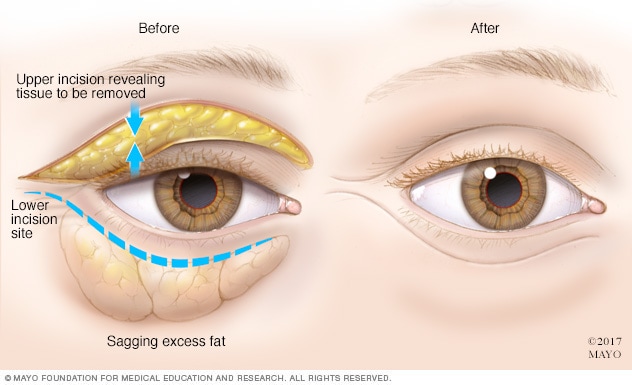Diagnosis
Bags under eyes are evident without a medical diagnosis. You may have the skin under your eyes assessed by a healthcare professional to learn more about what's causing the puffiness or if you're interested in medical or surgical treatment.
Treatment
How blepharoplasty is done

How blepharoplasty is done
During blepharoplasty, the surgeon cuts into the creases of the eyelids to trim sagging skin and muscle and remove excess fat. The surgeon rejoins the skin with tiny dissolving stitches.
Bags under eyes are usually a cosmetic concern and don't require medical treatment. Home and lifestyle treatments may help reduce puffiness. But if you're concerned about the appearance of under-eye swelling, medical and surgical treatments are available. Treatment may not be covered by medical insurance if it's done solely to improve your appearance.
Medications
If you think the swelling under your eyes is caused by an allergy, ask your health care provider about prescription allergy medication.
Therapies
Various wrinkle treatments are used to improve the appearance of puffiness under the eyes. These include laser resurfacing, chemical peels and fillers, which may improve skin tone, tighten the skin and rejuvenate the under-eye area. For people with brown or Black skin, laser resurfacing carries the risk of permanent changes in skin color (hyperpigmentation or hypopigmentation). Talk with your health care provider about which laser resurfacing technique reduces this risk.
Eyelid surgery
Depending on what's causing bags under the eyes, eyelid surgery (blepharoplasty) may be a treatment option. Your surgeon will tailor your blepharoplasty (BLEF-uh-roe-plas-tee) to your unique anatomy and needs, but in general the procedure involves removing excess fat through an incision in the natural crease of the upper eyelid or inside the lower lid. The procedure is usually done in an outpatient setting with local anesthesia.
In addition to correcting bags under eyes, blepharoplasty can also repair:
- Baggy or puffy upper eyelids
- Excess skin of the upper eyelid that interferes with your vision
- Droopy lower eyelids, which may cause white to show below the iris — the colored part of the eye
- Excess skin on lower eyelids
Talk with your health care provider about the side effects of eyelid surgery — dry eyes, watery eyes, pain, swelling, bruising and blurred vision. Rare complications include visual loss, bleeding, infection, injury to eye muscles, corneal abrasion and drooping of an eyelid.
Lifestyle and home remedies
The following tips can help you reduce or eliminate bags under your eyes:
- Use a cool compress. Wet a clean washcloth with cool water. While sitting up, apply the damp washcloth to the skin under and around your eyes for a few minutes using light pressure.
- Cut down on fluids before bedtime and limit salt in your diet. This will reduce the fluid retention that can cause bags under eyes.
- Don't smoke. Smoking can aggravate the problem of bags under your eyes.
- Get enough sleep. For most adults, 7 to 9 hours is a good amount of sleep.
- Sleep with your head slightly raised. It may help to add an extra pillow or prop up the head of your mattress. Or elevate the entire head of the bed a few inches. This helps prevent fluid from accumulating around your eyes as you sleep.
- Reduce allergy symptoms. Avoid allergens when possible. Try nonprescription allergy medications. Talk to your health care provider about prevention strategies if you develop under-eye reactions due to hair dyes, soaps, cosmetics or other allergens.
- Use cosmetics. If you wish to mask your under-eye circles, try using makeup.
Preparing for your appointment
Preparing a list of questions will help you make the most of your time with your health care provider. For bags under eyes, some basic questions to ask your health care provider include:
- What's likely causing my symptoms?
- Is my condition likely temporary or chronic?
- What treatment approach do you recommend, if any?
- What will the treatments cost? Does medical insurance cover these costs?
- What results can I expect?
- Can I do anything at home to improve my symptoms?
- What kind of follow-up, if any, should I expect?
Don't hesitate to ask other questions that occur to you.
What to expect from your health care provider
Your health care provider is likely to ask you a number of questions, including:
- When did you first notice the puffiness under your eyes?
- Have your symptoms been continuous or occasional?
- What, if anything, seems to improve your symptoms?
- What, if anything, appears to worsen your symptoms?
- What medications do you use?
- Do you smoke?
- Do you consume alcohol?
- Do you use recreational drugs?
- What herbal supplements do you use?
- What other medical conditions do you have?
- Have you ever had bleeding disorders or blood clots?
Jan. 26, 2024